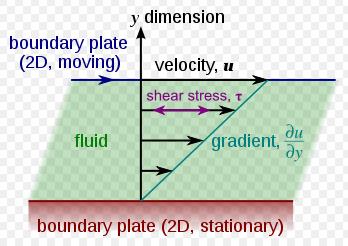Dynamic Viscosity
The resistance between two consecutive layers of fluid is viscosity. This resistance is generated because of the fact that different layers flow at different velocity. Or, in other words, there exists some amount of relative velocity which causes this friction.

The shear stress between consecutive fluid layers can be written as:
T = μ k……………………………………eqn.1
Where,
T – Shear stress between consecutive fluid layers
μ – Dynamic viscosity k – Velocity gradient, i.e. how much change in velocity occurs with depth of the fluid
SI (or MKS) Units of μ: N-s/m2 or Pa-s or kg/m-s. They all are equal, i.e., 1 N-s/m2 = 1 Pa-s = 1 kg/m-s.
CGS Units of μ: Poise or Dyne-s/cm2 or g/cm-s. The relation is: 1 Poise=1 Dyne-s/cm2 = 1 g/cm-s=100 centiPoise = 0.1Pa-s.
FPS unit of μ: Lb/ft-s. 1 lb/ft-s = 14.88 Poise
Kinematic viscosity It is the ratio between the dynamic viscosity and density. Use consistent units system while calculating the ratio. The units here are: m2/s , ft2/s and Stokes (St). 1 St = 10000 m2/s
References:
Hi, I am Shibashis, a blogger by passion and an engineer by profession. I have written most of the articles for mechGuru.com. For more than a decades i am closely associated with the engineering design/manufacturing simulation technologies. I am a self taught code hobbyist, presently in love with Python (Open CV / ML / Data Science /AWS -3000+ lines, 400+ hrs. )

Your article perfectly shows what I needed to know, tahkns!